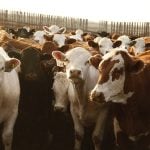
Tag Archives BSE

Simplified BSE testing shows good uptake
Canada changed its BSE surveillance after lower global incidence of ‘mad cow disease’ led to international standards shift

Canada says Australia has re-opened market access for beef and beef products

Canada’s BSE program has seen steps forward
Canadian cattle farmers and local veterinarians have a key role in maintaining Canada’s BSE negligible risk status that protects Canada’s beef trade

BSE testing drags on Canadian cattle sector
Canada has a clean bill of health when it comes to mad cow disease, but we’re still testing like we’re on high alert

Setting cattle aside may help buffer effects of U.S. tariffs
With the Trump tariff threat looming, should Canada’s beef sector start pondering an ask for a set-aside program, should the trade barriers be imposed?

Scotland reports case of mad cow disease

More BSE-era trade irritants may soon disappear
The Canadian Cattle Association continues to work on resolving specified risk material and U.S. cattle holdback issues

Taiwan formally opens to OTM Canadian beef
BSE-era restriction now lifted

20th anniversary reflections on BSE
The cattle sector looks back on the crisis that rocked the industry, and the profound changes that followed

Taiwan pledges full access for Canadian beef
Market to reopen in 'a couple weeks,' minister says


